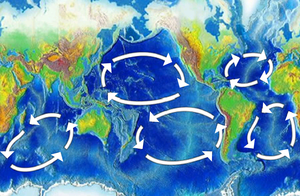
Back دوامة محيطية Arabic মহাসাগরীয় বলয় Bengali/Bangla Gir oceànic Catalan Gyre Danish Ocean gyre English Giro oceánico Spanish چرخاب FA Gyre océanique French Mórghuairneán GA समुद्री जायर HI

A gyre is a large system of ocean currents moving in a circle. Gyres are caused by the Coriolis effect. Because the Earth is rotating, ocean currents in the northern hemisphere tend to move in a clockwise direction and currents in the southern hemisphere move in an anti-clockwise direction.[1]
The Coriolis force acts most strongly on the wind, and the wind then creates a torque that tends to spin the ocean currents.[2]
The Earth rotates from the west towards the east, and the Coriolis effect becomes more intense toward the poles. Because of this, gyres form strong currents on the western side of oceans, so they are pushed against the eastern coast of continents.[1][2] The vorticity (the strength of the torque force) is balanced out by frictional surface currents, which normally act against the spin of the water. However, in the middle of the ocean, the effects of friction are very weak.[2][3]
The term gyre can be used to mean any type of vortex in the air or the sea, but it is most used in oceanography for the major ocean current systems.
- ↑ 1.0 1.1 "Gyres and the Coriolis effect". Blue Planet: Infobursts. British Broadcasting Corporation. Archived from the original on 4 July 2013. Retrieved 6 October 2013.
- ↑ 2.0 2.1 2.2 Geoffrey K. Vallis (10 October 2011). Climate and the Oceans. pp. 83–85. ISBN 978-1400840625.
- ↑ B. Heinemann; Open University (1998). Ocean circulation. Oxford University Press. p. 98.